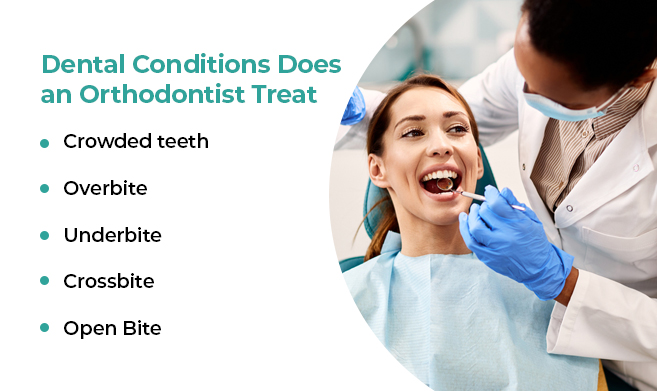Indicators on Legacy Orthodontics You Need To Know
Wiki Article
Some Ideas on Legacy Orthodontics You Need To Know
Table of Contents7 Easy Facts About Legacy Orthodontics DescribedLegacy Orthodontics Things To Know Before You BuyLegacy Orthodontics for BeginnersThe Ultimate Guide To Legacy OrthodonticsThe 2-Minute Rule for Legacy Orthodontics
In enhancement, we supply flexible treatment routines, versatile repayment choices and an enjoyable, pleasurable experience.An orthodontist is a dentist educated to diagnose, stop, and deal with teeth and jaw abnormalities. Orthodontists function with individuals of all ages, from youngsters to grownups.
Malocclusion, or misaligned teeth, can cause dental problems, including tooth decay, gum tissue disease, and challenging or uncomfortable eating. But not everyone is birthed with straight teeth. If you have a bad bite or huge spaces between your teeth, you may intend to consult a dentist focusing on orthodontic treatment.
A Biased View of Legacy Orthodontics
( Image Credit Rating: DigitalVision/Getty Images) Orthodontists use dealt with and removable dental tools, like dental braces, retainers, and bands, to transform the placement of teeth in your mouth. Orthodontic therapy is for oral problems, including: Jagged teethBite problems, like an overbite or an underbiteCrowded teeth or teeth that are as well far apartJaw misalignmentThe goal of orthodontic therapy is to improve your bite.A healthy and balanced bite guarantees you can eat, eat, and talk correctly. While you might think about orthodontists as generally for youngsters or teenagers that need braces, they can deal with dental troubles at any type of age. Orthodontists go to college, dental college, and orthodontic school. After graduation, they invest 2 or 3 years in an orthodontic residency program.
All orthodontists are dental experts, but not all dental professionals are orthodontists. Orthodontic residency programs supply intensive, focused direction for oral experts. They concentrate on 2 areas: Just how to appropriately and safely move teeth How to correctly guide development in the teeth, jaw, and faceOnce an orthodontist has finished training, they have the option to come to be board licensed.
Legacy Orthodontics for Dummies
Imbalance, or malocclusion, is one of the most typical reason individuals see an orthodontist. It is hereditary and is the outcome of dimension differences between the top and lower jaw or in between the jaw and teeth. Malocclusion results in tooth overcrowding, an irregular jaw, or irregular bite patterns. Malocclusion is typically treated with: Your orthodontist attaches steel, ceramic, or plastic square bonds to your teeth.If you have only small malocclusion, you may be able to use clear dental braces, called aligners, rather than traditional braces (https://www.pageorama.com/?p=legacyortho). Some individuals need a headwear to aid move teeth right into line with stress from outside the mouth. After dental braces or aligners, you'll require to use a retainer. A retainer is a custom device that maintains your teeth in position.
They can develop added area in the mouth without having to draw teeth. Orthodontists utilize wires, surgical screws, or plates to support your jaw bone.
You might need to see an orthodontist if you have: Crowding or not sufficient area for every one of your teethOverbite, when your upper teeth come your bottom teethUnderbite, when your bottom teeth are as well pop over to this site far forwardSpacing or problems with gapsCrossbite, which is when your upper teeth fit behind your bottom teeth when your mouth is closedOpen bite or a vertical space in between your front bottom and upper teethMisplaced midline, when the facility of your base and upper teeth do not line up Correcting a dental malocclusion can: Make biting, eating, and speaking easierImprove the balance of our face and your overall appearanceEase pain from temporomandibular joint problemsDifferent your teeth and make them less complicated to clean, aiding avoid dental cavity or dental caries It's often a dental expert that first notices misaligned teeth during a routine examination.
Legacy Orthodontics Fundamentals Explained

Throughout your initial orthodontic appointment, you'll likely have: A dental examPhotos taken of your face and smileDental X-raysPanoramic (360 degree) X-rays of your face and headImpressions to create mold and mildews of your teethThese examinations will certainly assist your orthodontist understand how to proceed with your therapy. leesburg orthodontist. An orthodontist is a dental professional that's had training to treat your teeth and jaw
An orthodontist is concentrated on your bite, so something like a cracked tooth would certainly be managed by a dentist. Orthodontists are concentrated on your bite, or the method your teeth fit together, and the straightness of your teeth. Ever wondered just how celebrities always seem to have completely lined up teeth? Orthodontists are oral professionals that concentrate on dealing with abnormalities in the teeth and jaws.
The Ultimate Guide To Legacy Orthodontics

, orthodontists have a varied toolkit at their disposal. These tried-and-true braces make use of a system of brackets bound to the teeth and connected by cords.
Clear aligners, like Invisalign, are a popular option for patients looking for a more very discreet therapy alternative. These removable trays are personalized to progressively change the teeth's position. Headgear may be used along with braces or aligners to apply additional targeted forces, specifically for dealing with jaw disparities. In instances of narrow jaws, palatal expanders can be utilized to create area for proper tooth alignment.
Report this wiki page